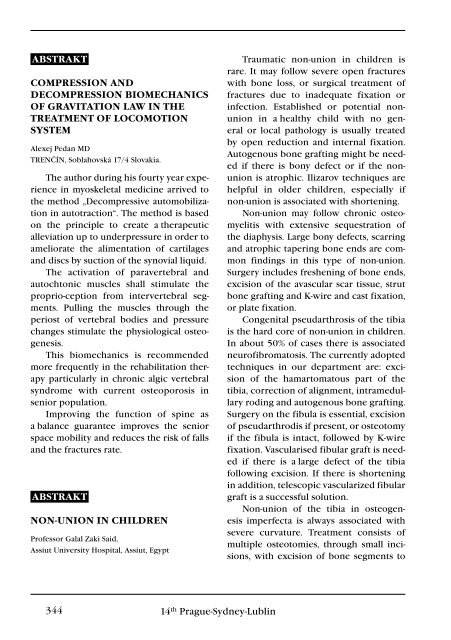3+4+Supplementum/2012 - Společnost pro pojivové tkáně
3+4+Supplementum/2012 - Společnost pro pojivové tkáně
3+4+Supplementum/2012 - Společnost pro pojivové tkáně
- TAGS
- www.pojivo.cz
You also want an ePaper? Increase the reach of your titles
YUMPU automatically turns print PDFs into web optimized ePapers that Google loves.
aBSTRakT<br />
COMPReSSiOn and<br />
deCOMPReSSiOn BiOMeCHaniCS<br />
Of GRaViTaTiOn law in THe<br />
TReaTMenT Of lOCOMOTiOn<br />
SYSTeM<br />
Alexej Pedan MD<br />
TRENČÍN, Soblahovská 17/4 Slovakia.<br />
The author during his fourty year experience<br />
in myoskeletal medicine arrived to<br />
the method „Decompressive automobilization<br />
in autotraction“. The method is based<br />
on the principle to create a therapeutic<br />
alleviation up to underpressure in order to<br />
ameliorate the alimentation of cartilages<br />
and discs by suction of the synovial liquid.<br />
The activation of paravertebral and<br />
autochtonic muscles shall stimulate the<br />
<strong>pro</strong>prio-ception from intervertebral segments.<br />
Pulling the muscles through the<br />
periost of vertebral bodies and pressure<br />
changes stimulate the physiological osteogenesis.<br />
This biomechanics is recommended<br />
more frequently in the rehabilitation therapy<br />
particularly in chronic algic vertebral<br />
syndrome with current osteoporosis in<br />
senior population.<br />
Im<strong>pro</strong>ving the function of spine as<br />
a balance guarantee im<strong>pro</strong>ves the senior<br />
space mobility and reduces the risk of falls<br />
and the fractures rate.<br />
aBSTRakT<br />
nOn-uniOn in CHildRen<br />
Professor Galal Zaki Said,<br />
Assiut University Hospital, Assiut, Egypt<br />
344 14 th Prague-Sydney-Lublin<br />
Traumatic non-union in children is<br />
rare. It may follow severe open fractures<br />
with bone loss, or surgical treatment of<br />
fractures due to inadequate fixation or<br />
infection. Established or potential nonunion<br />
in a healthy child with no general<br />
or local pathology is usually treated<br />
by open reduction and internal fixation.<br />
Autogenous bone grafting might be needed<br />
if there is bony defect or if the nonunion<br />
is atrophic. Ilizarov techniques are<br />
helpful in older children, especially if<br />
non-union is associated with shortening.<br />
Non-union may follow chronic osteomyelitis<br />
with extensive sequestration of<br />
the diaphysis. Large bony defects, scarring<br />
and atrophic tapering bone ends are common<br />
findings in this type of non-union.<br />
Surgery includes freshening of bone ends,<br />
excision of the avascular scar tissue, strut<br />
bone grafting and K-wire and cast fixation,<br />
or plate fixation.<br />
Congenital pseudarthrosis of the tibia<br />
is the hard core of non-union in children.<br />
In about 50% of cases there is associated<br />
neurofibromatosis. The currently adopted<br />
techniques in our department are: excision<br />
of the hamartomatous part of the<br />
tibia, correction of alignment, intramedullary<br />
roding and autogenous bone grafting.<br />
Surgery on the fibula is essential, excision<br />
of pseudarthrodis if present, or osteotomy<br />
if the fibula is intact, followed by K-wire<br />
fixation. Vascularised fibular graft is needed<br />
if there is a large defect of the tibia<br />
following excision. If there is shortening<br />
in addition, telescopic vascularized fibular<br />
graft is a successful solution.<br />
Non-union of the tibia in osteogenesis<br />
imperfecta is always associated with<br />
severe curvature. Treatment consists of<br />
multiple osteotomies, through small incisions,<br />
with excision of bone segments to

















